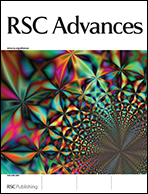Kinetic and thermodynamic study of 2′-hydroxy-8-methoxyflavylium. Reaction network interconverting flavylium cation and flavanone†
Abstract
2′-Hydroxyflavylium and 2′-hydroxyflavanone derivatives can be interconverted by a precise sequence of pH jumps, through the respective intermediate (mono) ionized trans-chalcones. In acidic and neutral media, the well known network of chemical reactions involving flavylium cation, quinoidal base, hemiketal, and cis and trans chalcones is established. In the pH range 8 < pH < 10, the chalcone (Ct) deprotonates and evolves to the formation of a flavanone (F). At higher pH values, the di-ionized trans-chalcone is the stable species, formed from the flavylium cation. Acidification of the di-ionized trans-chalcone gives the flavylium cation or the flavanone, via the mono-ionized trans-chalcone, respectively at pH < 1 and pH ≈ 9. In contrast with the chalcones, the flavanone once formed is stable even in acidic media. However, under strongly basic conditions, it leads back to the di-ionized trans-chalcone, the most stable species at more basic pH values, and the reactions leading to Ct−, F, Ct2−, Ct−, constitute a one direction cycle for interconversion of these species.


 Please wait while we load your content...
Please wait while we load your content...